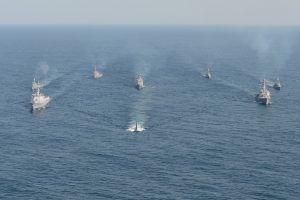In its Navy Vision 2045 plan, launched in 2018, the Republic of Korea Navy (ROKN) announced that it would develop a light aircraft carrier (CVX) capable of fielding a wing of F-35B short take-off vertical landing (STOVL) aircraft. The CVX, a twin island flat-top that can carry roughly 20 fixed-wing aircraft, will be at the heart of the ROKN’s plans for a strategic mobile fleet for blue water operations, improving its ability to project air power far from South Korean shores.
The ROKN’s carrier aspirations have encountered no shortage of criticism from pundits and analysts, both foreign and domestic. First, critics claim that the CVX is useless in the face of the main threat to South Korean security, North Korea, and is therefore a costly distraction. Second, the CVX’s detractors contend that a ROKN CVX would be too vulnerable to be of use in protecting South Korea’s broader maritime interests given an increasingly threatening regional environment.
We believe these critiques are mistaken. Below, we will refute each in turn in order to demonstrate that a ROKN carrier is not as improvident as its critics suggest.
A Costly Distraction?
A number of pundits argue that North Korea is the primary threat to South Korea’s security and that aircraft carriers, designed to project air power far from a state’s shores, are imprudent and superfluous. North Korea, they point out, is already in range of South Korea’s land-based airpower.
This criticism fails to grasp the utility of a ROKN carrier in the event of a clash with North Korea. In the event of war, North Korea would likely launch a barrage of attacks against ROK airbases, employing special operations forces, chemical weapons, and ballistic missiles. A carrier wing based at sea would be less susceptible to this initial strike and would therefore be ready to respond more swiftly and effectively. Additionally, a CVX would enable ROKN fighter aircraft to approach targets in North Korea via less well-defended avenues of approach north of the DMZ.
Just as importantly, this critique rests on a short-sighted miscalculation of South Korea’s interests. Yes, North Korea remains the most immediate threat to South Korean security. But South Korea has capable land forces and a powerful ally in the United States, which serve to deter this threat. North Korea’s military, while quantitatively formidable, is antiquated, poorly trained, and faces serious deficiencies in its sustainment capabilities.
South Korea is considerably less well-prepared to defend its far-flung maritime interests against rising threats and challenges at sea in the broader Indo-Pacific region. In particular, South Korea is highly susceptible to maritime threats to sea lanes of communication (SLOCs) given its extensive dependence on seaborne trade and energy. A mobile fleet based around the CVX would be capable of carrying out missions far from Korean shores to better secure these SLOCs. This fleet would be especially useful if it were integrated into a coalition effort, working alongside other capable fleets to maintain a free and open maritime commons. The very presence of this capability will help better deter adversaries from targeting South Korea’s maritime interests.
A Vulnerable Target?
Skeptics assert that a ROKN carrier would simply be a sitting duck in the face of more capable regional maritime powers and new anti-ship weapons systems. In particular, the CVX’s detractors point to the proliferation of formidable anti-surface capabilities, including long-range anti-ship ballistic missiles and more capable submarines.
This criticism is overstated. Anti-ship missiles and submarines will likely make carriers more vulnerable in the Indo-Pacific. But carriers are still quite difficult to detect and target effectively. Furthermore, South Korea’s CVX is relatively small with a 40,000 ton displacement, making it even harder to detect and strike than its U.S. supercarrier counterparts. Finally, a ROKN CVX would be deployed alongside a range of escorts equipped with anti-missile, air defense, and anti-submarine warfare capabilities designed to further insulate the CVX against attack.
Some pundits also suggest that a single ROKN carrier group would be insufficient to contest, let alone establish, sea control in the face of more capable regional powers. If China, for instance, were to threaten South Korean SLOCs, a single ROKN carrier trying to keep those SLOCs open might face virtually insurmountable odds.
But this criticism ignores important context. If the ROKN were forced to contend with a regional power with superior naval capabilities, it would almost certainly be operating in concert with its U.S. ally. It is difficult to conceive of a scenario where this would not be the case. The United States has made clear time and again its commitment to South Korean security and to the freedom of the maritime commons. In this context, a ROKN light carrier would prove much more effective and less vulnerable, working with U.S. forces to jointly fend off threats to its regional SLOCs.
To this point, some might argue that South Korea should simply allow the United States to carry to burden of maintaining regional maritime security and openness. Again, this criticism is short-sighted. The U.S. is still committed to preserving a free and open Indo-Pacific, but it also faces mounting fiscal constraints and strengthened regional competitors. Consequently, Washington routinely calls on Seoul to do more to promote regional security beyond the Korean Peninsula. A ROKN carrier group would support an overstretched U.S. while also highlighting the enduring value of South Korea as an alliance partner and an emerging regional leader.
The costs and challenges involved in the creation and operation of a light aircraft carrier cannot be ignored or wished away. The ROKN’s new carrier will take time, effort, and resources. It will require extensive logistical support to operate far from Korean shores for extended periods of time. But suggestions that these resources will have little to no payoff for South Korean national security are mistaken.

































